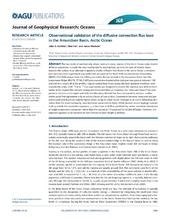Observational validation of the diffusive convection flux laws in the Amundsen Basin, Arctic Ocean
Peer reviewed, Journal article
Published version

Åpne
Permanent lenke
https://hdl.handle.net/1956/17679Utgivelsesdato
2015-12Metadata
Vis full innførselSamlinger
- Geophysical Institute [1198]
Originalversjon
https://doi.org/10.1002/2015jc010884Sammendrag
The low levels of mechanically driven mixing in many regions of the Arctic Ocean make double diffusive convection virtually the only mechanism for moving heat up from the core of Atlantic Water towards the surface. In an attempt to quantify double diffusive heat fluxes in the Arctic Ocean, a temperature microstructure experiment was performed as a part of the North Pole Environmental Observatory (NPEO) 2013 field season from the drifting ice station Barneo located in the Amundsen Basin near the Lomonosov Ridge (89.58N, 758W). A diffusive convective thermohaline staircase was present between 150 and 250 m in nearly all of the profiles. Typical vertical heat fluxes across the high-gradient interfaces were consistently small, O(1021 )Wm22 . Our experiment was designed to resolve the staircase and differed from earlier Arctic studies that utilized inadequate instrumentation or sampling. Our measured fluxes from temperature microstructure agree well with the laboratory derived flux laws compared to previous studies, which could find agreement only to within a factor of two to four. Correlations between measured and parameterized heat fluxes are slightly higher when using the more recent Flanagan et al. [2013] laboratory derivation than the more commonly used derivation presented in Kelley [1990]. Nusselt versus Rayleigh number scaling reveals the convective exponent, g, to be closer to 0.29 as predicted by recent numerical simulations of single-component convection rather than the canonical 1/3 assumed for double diffusion. However, the exponent appears to be sensitive to how convective layer height is defined.